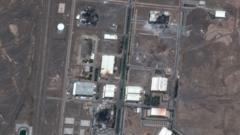Recent satellite imagery has revealed significant destruction at key Iranian nuclear locations and military installations, particularly at Natanz and a missile site near Tabriz. The International Atomic Energy Agency confirmed damage, while various perspectives on the incident highlight ongoing geopolitical implications.**
Analysis of Damage to Iranian Nuclear and Military Sites Following Recent Strikes**

Analysis of Damage to Iranian Nuclear and Military Sites Following Recent Strikes**
Satellite imagery has elucidated the extent of damage inflicted on Iran's nuclear and military infrastructure amid escalating regional tensions.**
The recent attacks on Iranian nuclear and military sites have generated substantial attention and concern internationally. Satellite imagery provided by Maxar and analyzed by BBC Verify has shed light on the damages incurred at critical facilities, particularly the Natanz nuclear site and missile infrastructure south of Tabriz.
The imagery showcases destruction at the Natanz facility, including significant damage to the pilot fuel enrichment plant and essential electrical systems. Rafael Grossi, the head of the International Atomic Energy Agency (IAEA), reported to the UN Security Council that the above-ground structures essential for uranium enrichment have been devastated. This is alarming, given that uranium-235 is crucial for both nuclear power generation and military applications.
Analysis of footage and images suggests that penetrating bombs, a tactic familiar from Israel’s past military interventions, may have been used in these operations. While Mr. Grossi noted there was no evidence of an underground attack on the cascade hall—where part of the uranium enrichment process takes place—this does not preclude the strategically significant damage inflicted elsewhere.
Additionally, the IAEA has acknowledged damage to four significant buildings in Isfahan, including the Uranium conversion facility and the fuel plate fabrication plant, though no increase in off-site radiation was reported. This suggests an intent to neutralize Iran’s nuclear capabilities without causing a catastrophic radiological event.
The strikes are also reported to have impacted missile installations, with imagery indicating damage to weapon storage, shelters, and silos. Analysis from Umbra Space highlighted severe damage to these military complexes, which underscores the ongoing military tensions in the region.
Furthermore, low-resolution images from Kermanshah indicated extensive burn marks in areas near missile bases, while confirmed footage displayed smoke clouds emerging from strike sites. Areas associated with the Iranian Revolutionary Guard Corps also showed signs of destruction, emphasizing the military targets' vulnerability.
The broader implications of these strikes extend beyond the immediate loss of infrastructure. They reflect the continued instability in the region, with a counter-response expected from Iran, which may escalate tensions further. As the situation unfolds, the international community watches closely for reactions that could influence regional security dynamics.
The imagery showcases destruction at the Natanz facility, including significant damage to the pilot fuel enrichment plant and essential electrical systems. Rafael Grossi, the head of the International Atomic Energy Agency (IAEA), reported to the UN Security Council that the above-ground structures essential for uranium enrichment have been devastated. This is alarming, given that uranium-235 is crucial for both nuclear power generation and military applications.
Analysis of footage and images suggests that penetrating bombs, a tactic familiar from Israel’s past military interventions, may have been used in these operations. While Mr. Grossi noted there was no evidence of an underground attack on the cascade hall—where part of the uranium enrichment process takes place—this does not preclude the strategically significant damage inflicted elsewhere.
Additionally, the IAEA has acknowledged damage to four significant buildings in Isfahan, including the Uranium conversion facility and the fuel plate fabrication plant, though no increase in off-site radiation was reported. This suggests an intent to neutralize Iran’s nuclear capabilities without causing a catastrophic radiological event.
The strikes are also reported to have impacted missile installations, with imagery indicating damage to weapon storage, shelters, and silos. Analysis from Umbra Space highlighted severe damage to these military complexes, which underscores the ongoing military tensions in the region.
Furthermore, low-resolution images from Kermanshah indicated extensive burn marks in areas near missile bases, while confirmed footage displayed smoke clouds emerging from strike sites. Areas associated with the Iranian Revolutionary Guard Corps also showed signs of destruction, emphasizing the military targets' vulnerability.
The broader implications of these strikes extend beyond the immediate loss of infrastructure. They reflect the continued instability in the region, with a counter-response expected from Iran, which may escalate tensions further. As the situation unfolds, the international community watches closely for reactions that could influence regional security dynamics.





















